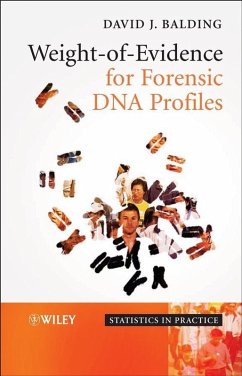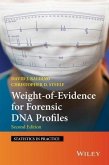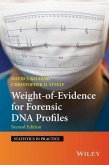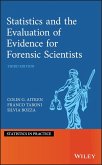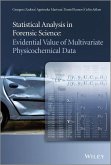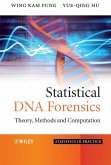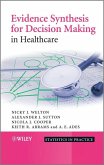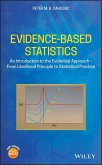Weight-of-Evidence for Forensic DNA Profiles (eBook, PDF)


Alle Infos zum eBook verschenken

Weight-of-Evidence for Forensic DNA Profiles (eBook, PDF)
- Format: PDF
- Merkliste
- Auf die Merkliste
- Bewerten Bewerten
- Teilen
- Produkt teilen
- Produkterinnerung
- Produkterinnerung

Hier können Sie sich einloggen

Bitte loggen Sie sich zunächst in Ihr Kundenkonto ein oder registrieren Sie sich bei bücher.de, um das eBook-Abo tolino select nutzen zu können.
Assessing Weight-of-Evidence for DNA Profiles is an excellent introductory text to the use of statistical analysis for assessing DNA evidence. It offers practical guidance to forensic scientists with little dependence on mathematical ability as the book includes background information on statistics - including likelihood ratios - population genetics, and courtroom issues. The author, who is highly experienced in this field, has illustrated the book throughout with his own experiences as well as providing a theoretical underpinning to the subject. It is an ideal choice for forensic scientists…mehr
- Geräte: PC
- mit Kopierschutz
- eBook Hilfe
- Größe: 1.5MB
![Weight-of-Evidence for Forensic DNA Profiles (eBook, PDF) Weight-of-Evidence for Forensic DNA Profiles (eBook, PDF)]() David J. BaldingWeight-of-Evidence for Forensic DNA Profiles (eBook, PDF)73,99 €
David J. BaldingWeight-of-Evidence for Forensic DNA Profiles (eBook, PDF)73,99 €![Weight-of-Evidence for Forensic DNA Profiles (eBook, ePUB) Weight-of-Evidence for Forensic DNA Profiles (eBook, ePUB)]() David J. BaldingWeight-of-Evidence for Forensic DNA Profiles (eBook, ePUB)73,99 €
David J. BaldingWeight-of-Evidence for Forensic DNA Profiles (eBook, ePUB)73,99 €![Statistics and the Evaluation of Evidence for Forensic Scientists (eBook, PDF) Statistics and the Evaluation of Evidence for Forensic Scientists (eBook, PDF)]() Colin AitkenStatistics and the Evaluation of Evidence for Forensic Scientists (eBook, PDF)119,99 €
Colin AitkenStatistics and the Evaluation of Evidence for Forensic Scientists (eBook, PDF)119,99 €![Statistical Analysis in Forensic Science (eBook, PDF) Statistical Analysis in Forensic Science (eBook, PDF)]() Grzegorz ZadoraStatistical Analysis in Forensic Science (eBook, PDF)78,99 €
Grzegorz ZadoraStatistical Analysis in Forensic Science (eBook, PDF)78,99 €![Statistical DNA Forensics (eBook, PDF) Statistical DNA Forensics (eBook, PDF)]() Wing Kam FungStatistical DNA Forensics (eBook, PDF)94,99 €
Wing Kam FungStatistical DNA Forensics (eBook, PDF)94,99 €![Evidence Synthesis for Decision Making in Healthcare (eBook, PDF) Evidence Synthesis for Decision Making in Healthcare (eBook, PDF)]() Nicky J. WeltonEvidence Synthesis for Decision Making in Healthcare (eBook, PDF)61,99 €
Nicky J. WeltonEvidence Synthesis for Decision Making in Healthcare (eBook, PDF)61,99 €![Evidence-Based Statistics (eBook, PDF) Evidence-Based Statistics (eBook, PDF)]() Peter M. B. CahusacEvidence-Based Statistics (eBook, PDF)95,99 €
Peter M. B. CahusacEvidence-Based Statistics (eBook, PDF)95,99 €-
-
-
Dieser Download kann aus rechtlichen Gründen nur mit Rechnungsadresse in A, B, BG, CY, CZ, D, DK, EW, E, FIN, F, GR, HR, H, IRL, I, LT, L, LR, M, NL, PL, P, R, S, SLO, SK ausgeliefert werden.
- Produktdetails
- Verlag: John Wiley & Sons
- Seitenzahl: 198
- Erscheinungstermin: 11. April 2005
- Englisch
- ISBN-13: 9780470867662
- Artikelnr.: 38205929
- Verlag: John Wiley & Sons
- Seitenzahl: 198
- Erscheinungstermin: 11. April 2005
- Englisch
- ISBN-13: 9780470867662
- Artikelnr.: 38205929
- Herstellerkennzeichnung Die Herstellerinformationen sind derzeit nicht verfügbar.
36 3.5.1 Bayes theorem for identification evidence 37 3.5.2 Uncertainty about p and N 38 3.5.3 Grouping the alternative possible culprits 39 3.5.4 Typing errors 40 3.6 Further weight-of-evidence exercises 40 4 Typing technologies 43 4.1 STR typing 44 4.1.1 Anomalies 46 4.1.2 Contamination 49 4.1.3 Low copy number (LCN) profiling 50 4.2 mtDNA typing 50 4.3 Y-chromosome markers 51 4.4 X-chromosome markers
52 4.5 SNP profiles 53 4.6 Fingerprints
54 5 Some population genetics for DNA evidence 56 5.1 A brief overview 56 5.1.1 Drift 56 5.1.2 Mutation 59 5.1.3 Migration 60 5.1.4 Selection 60 5.2
, or FST 62 5.3 A statistical model and sampling formula 63 5.3.1 Diallelic loci 63 5.3.2 Multi-allelic loci 68 5.4 Hardy-Weinberg equilibrium 69 5.4.1 Testing for deviations from HWE
70 5.4.2 Interpretation of test results 74 5.5 Linkage equilibrium 75 5.6 Coancestry
77 5.7 Likelihood-based estimation of
79 5.8 Population genetics exercises 81 6 Identification 82 6.1 Choosing the hypotheses 82 6.1.1 Post-data equivalence of hypotheses 84 6.2 Calculating likelihood ratios 85 6.2.1 The match probability 85 6.2.2 One locus 87 6.2.3 Multiple loci: the "product rule" 89 6.2.4 Relatives of s 90 6.2.5 Confidence limits
92 6.2.6 Other profiled individuals 93 6.3 Application to STR profiles 94 6.3.1 Values for the pj 95 6.3.2 The value of
96 6.3.3 Errors 98 6.4 Application to haploid profiles 99 6.4.1 mtDNA profiles 99 6.4.2 Y-chromosome markers 101 6.5 Mixtures 101 6.5.1 Visual interpretation of mixed profiles 101 6.5.2 Likelihood ratios under qualitative interpretation 103 6.5.3 Quantitative interpretation of mixtures 108 6.6 Identification exercises 109 7 Relatedness 111 7.1 Paternity 111 7.1.1 Weight of evidence for paternity 111 7.1.2 Prior probabilities 112 7.1.3 Calculating likelihood ratios 113 7.1.4 Multiple loci: the effect of linkage 117 7.1.5 s may be related to c but is not the father 119 7.1.6 Incest 120 7.1.7 Mother unavailable 121 7.1.8 Mutation 122 7.2 Other relatedness between two individuals 126 7.2.1 Only the two individuals profiled 126 7.2.2 Profiled individual close relative of target 127 7.2.3 Profiles of known relatives also available
128 7.3 Software for relatedness analyses 129 7.4 Inference of ethnicity or phenotype
131 7.5 Relatedness exercises 133 8 Other approaches to weight of evidence 135 8.1 Uniqueness 135 8.1.1 Analysis 136 8.1.2 Discussion 138 8.2 Inclusion/exclusion probabilities 138 8.2.1 Random man 138 8.2.2 Inclusion probability of a typing system 139 8.2.3 Case-specific inclusion probability 139 8.3 Hypothesis testing
141 8.4 Other exercises 143 9 Issues for the courtroom 145 9.1 Bayesian reasoning in court 145 9.2 Some fallacies 146 9.2.1 The prosecutor's fallacy 146 9.2.2 The defendant's fallacy 147 9.2.3 The uniqueness fallacy 148 9.3 Some UK appeal cases 148 9.3.1 Deen (1993) 148 9.3.2 Dalby (1995) 149 9.3.3 Adams (1996) 149 9.3.4 Doheny/Adams (1996) 151 9.3.5 Watters (2000) 153 9.4 US National Research Council reports 154 9.5 Prosecutor's fallacy exercises 155 10 Solutions to exercises 157 Bibliography 175 Index 183
36 3.5.1 Bayes theorem for identification evidence 37 3.5.2 Uncertainty about p and N 38 3.5.3 Grouping the alternative possible culprits 39 3.5.4 Typing errors 40 3.6 Further weight-of-evidence exercises 40 4 Typing technologies 43 4.1 STR typing 44 4.1.1 Anomalies 46 4.1.2 Contamination 49 4.1.3 Low copy number (LCN) profiling 50 4.2 mtDNA typing 50 4.3 Y-chromosome markers 51 4.4 X-chromosome markers
52 4.5 SNP profiles 53 4.6 Fingerprints
54 5 Some population genetics for DNA evidence 56 5.1 A brief overview 56 5.1.1 Drift 56 5.1.2 Mutation 59 5.1.3 Migration 60 5.1.4 Selection 60 5.2
, or FST 62 5.3 A statistical model and sampling formula 63 5.3.1 Diallelic loci 63 5.3.2 Multi-allelic loci 68 5.4 Hardy-Weinberg equilibrium 69 5.4.1 Testing for deviations from HWE
70 5.4.2 Interpretation of test results 74 5.5 Linkage equilibrium 75 5.6 Coancestry
77 5.7 Likelihood-based estimation of
79 5.8 Population genetics exercises 81 6 Identification 82 6.1 Choosing the hypotheses 82 6.1.1 Post-data equivalence of hypotheses 84 6.2 Calculating likelihood ratios 85 6.2.1 The match probability 85 6.2.2 One locus 87 6.2.3 Multiple loci: the "product rule" 89 6.2.4 Relatives of s 90 6.2.5 Confidence limits
92 6.2.6 Other profiled individuals 93 6.3 Application to STR profiles 94 6.3.1 Values for the pj 95 6.3.2 The value of
96 6.3.3 Errors 98 6.4 Application to haploid profiles 99 6.4.1 mtDNA profiles 99 6.4.2 Y-chromosome markers 101 6.5 Mixtures 101 6.5.1 Visual interpretation of mixed profiles 101 6.5.2 Likelihood ratios under qualitative interpretation 103 6.5.3 Quantitative interpretation of mixtures 108 6.6 Identification exercises 109 7 Relatedness 111 7.1 Paternity 111 7.1.1 Weight of evidence for paternity 111 7.1.2 Prior probabilities 112 7.1.3 Calculating likelihood ratios 113 7.1.4 Multiple loci: the effect of linkage 117 7.1.5 s may be related to c but is not the father 119 7.1.6 Incest 120 7.1.7 Mother unavailable 121 7.1.8 Mutation 122 7.2 Other relatedness between two individuals 126 7.2.1 Only the two individuals profiled 126 7.2.2 Profiled individual close relative of target 127 7.2.3 Profiles of known relatives also available
128 7.3 Software for relatedness analyses 129 7.4 Inference of ethnicity or phenotype
131 7.5 Relatedness exercises 133 8 Other approaches to weight of evidence 135 8.1 Uniqueness 135 8.1.1 Analysis 136 8.1.2 Discussion 138 8.2 Inclusion/exclusion probabilities 138 8.2.1 Random man 138 8.2.2 Inclusion probability of a typing system 139 8.2.3 Case-specific inclusion probability 139 8.3 Hypothesis testing
141 8.4 Other exercises 143 9 Issues for the courtroom 145 9.1 Bayesian reasoning in court 145 9.2 Some fallacies 146 9.2.1 The prosecutor's fallacy 146 9.2.2 The defendant's fallacy 147 9.2.3 The uniqueness fallacy 148 9.3 Some UK appeal cases 148 9.3.1 Deen (1993) 148 9.3.2 Dalby (1995) 149 9.3.3 Adams (1996) 149 9.3.4 Doheny/Adams (1996) 151 9.3.5 Watters (2000) 153 9.4 US National Research Council reports 154 9.5 Prosecutor's fallacy exercises 155 10 Solutions to exercises 157 Bibliography 175 Index 183
